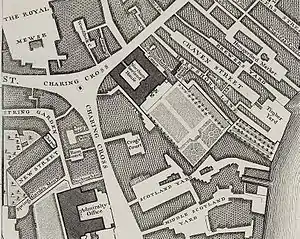
Craven Street is a street in the City of Westminster, London, near Strand. A number of notable historical figures have lived in the street which was the home of Benjamin Franklin when he lived in London before the American Revolution.
History
The street was originally known as Spur Alley. It was rebuilt around 1730 when the land was owned by the Craven family and it received its current name then.[1]
Location

Craven Street runs from Strand in the north to Northumberland Avenue in the south. Corner House Street and Hungerford Lane join Craven Street in the north and half way along Craven Street it is crossed by Craven Passage which is pedestrian only and joins Craven Street to Northumberland Street and Hungerford Lane. Hungerford Lane rejoins Craven Street at its southern end.
Residents
Mark Akenside, author of The Pleasures of the Imagination, lived at No. 33 from 1759 to 1761.[2]

Benjamin Franklin lived at No. 36 for sixteen years before the American Revolution. The house is a Grade I listed building with Historic England and now functions as a museum known as Benjamin Franklin House.[3]
Pioneer of haematology William Hewson, lived at No. 36 for two years from 1772 at the same time as Franklin. In 1998 workmen discovered the remains of six children and four adults underneath the house which may relate to medical experiments carried out by Hewson.
Aaron Burr, 3rd Vice President of the United States lived abroad from 1808 to 1812, passing most of his time in England, where he occupied a house on Craven Street in London.
German poet Heinrich Heine lived at No. 32 in 1827.[2] A plaque marks the house.

Herman Melville, author of Moby Dick, lived at No. 25 in 1849 when he visited London as a sailor during his youth.[2] A blue plaque marks the house.
References
- ↑ Hibbert, Christopher; Ben Weinreb; John Keay; Julia Keay (2010). The London Encyclopaedia. London: Pan Macmillan. p. 217. ISBN 978-0-230-73878-2.
- 1 2 3 Wheatley, Henry B. (1891). London past and present: Its history, associations, and traditions. Vol. I. London: John Murray. Cambridge University Press reprint, 2011. p. 605. ISBN 9781108028066.
- ↑ "About the House". Benjamin Franklin House.
External links
![]() Media related to Craven Street, London at Wikimedia Commons
51°30′27″N 0°07′29″W / 51.5074°N 0.1248°W
Media related to Craven Street, London at Wikimedia Commons
51°30′27″N 0°07′29″W / 51.5074°N 0.1248°W